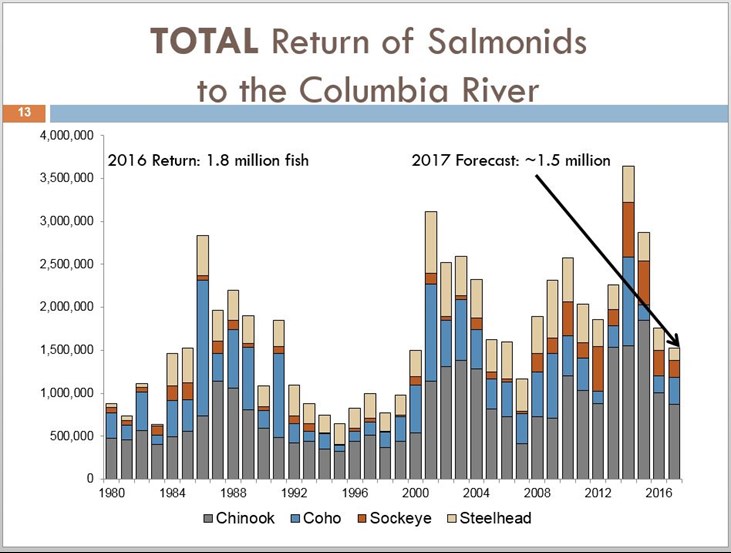forum
library
tutorial
contact

Fish Forecast:
'Not Very Good'
by John Harrison
NW Power & Conservation Council, March 15, 2017
|
the film forum library tutorial contact |

|
Fish Forecast:
by John Harrison
|
"At least in the Snake River, we're kind of stuck at a plateau," said Pete Hassamer,
anadromous fish manager for the Idaho Department of Fish and Game.
 Despite the lower predicted return this year, 1.5 million fish needs to be put in perspective, Washington Council member Guy Norman said. He remembers the comparatively lean years of the 1980s and 1990s, when he helped manage Columbia River fisheries for the Washington Department of Fish and Wildlife.
Despite the lower predicted return this year, 1.5 million fish needs to be put in perspective, Washington Council member Guy Norman said. He remembers the comparatively lean years of the 1980s and 1990s, when he helped manage Columbia River fisheries for the Washington Department of Fish and Wildlife.
"One year in the mid-1990s, the total upriver spring Chinook run was fewer than 13,000 fish," Norman said. "In terms of the big picture from 1980 through 2016, the last 15 years don't look too bad."
In the words of a Northwest fisheries expert, "the forecast is not looking very good" for salmon and steelhead returns to the Columbia River Basin this year -- about two-thirds of the recent 10-year average.
On the other hand, though, if this were the 1980s or 1990s and not 2017, the current prediction would be cause for celebration. That's because returns are a lot better today than in the past, thanks in large part to investments in habitat, hatcheries, and dam passage improvements over the last 30 years through the Council's Columbia River Basin Fish and Wildlife Program that have helped improve freshwater conditions for salmon and steelhead and contributed to improved runs.
The big X Factor, though, remains the inscrutable and varying Pacific Ocean, where salmon and steelhead spend one to five years before returning to spawn. Fish returning to the Columbia River Basin this year were subjected to poor ocean conditions over the last several years, and that likely contributed to the below-average returns this year, Brian Burke, an ocean expert with NOAA Fisheries, told the Council at a meeting this week.
Burke said a huge area of unusually warm water in the North Pacific, nicknamed "The Blob," persisted on and off from 2014 through 2016, affecting fish returning this year. Typically the warm water results in poor feeding conditions for fish by reducing the type and biomass of organisms, known as copepods, fish eat. The blob dissipated this year, and ocean conditions returned to normal. For now.
"With the blob, we saw a whole new species of copepods that we had not seen before," Burke said. "We also saw very few krill in the last two years, and they are an important food for salmon."
Ron Roler of the Washington Department of Fish and Wildlife said the total return to the Columbia River Basin this year is estimated at about 1.5 million fish. The 2016 return was 1.8 million, and the average over the last 10 years is about 2.2 million. The 2017 species-specific predictions for fish arriving at the mouth of the Columbia River include:
"One year in the mid-1990s, the total upriver spring Chinook run was fewer than 13,000 fish," Norman said. "In terms of the big picture from 1980 through 2016, the last 15 years don't look too bad."
Related Sites:
Overall Columbia River Basin salmon and steelhead forecast for 2017
Snake River-specific forecast
NOAA Fisheries forecast based on ocean conditions
learn more on topics covered in the film
see the video
read the script
learn the songs
discussion forum
